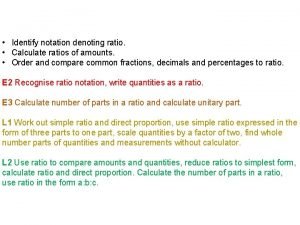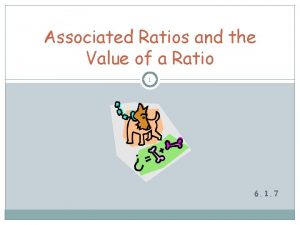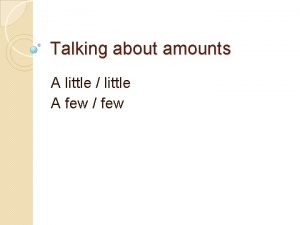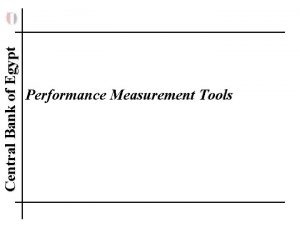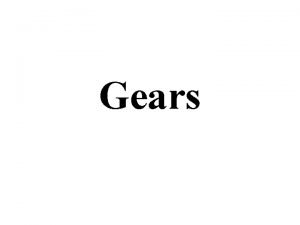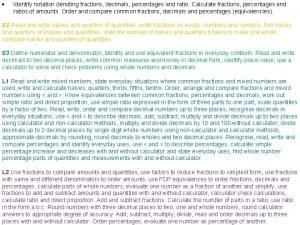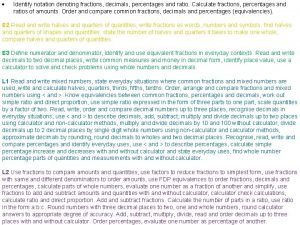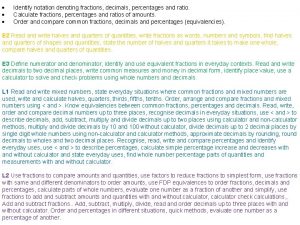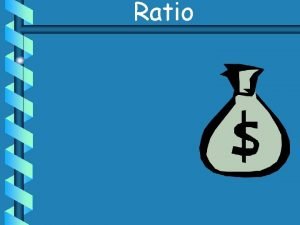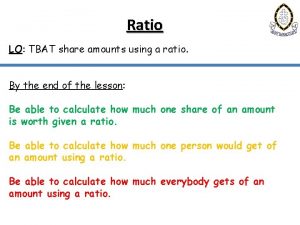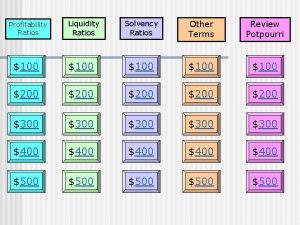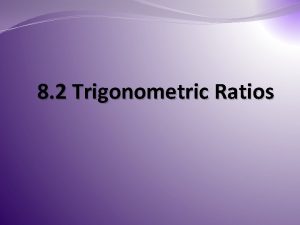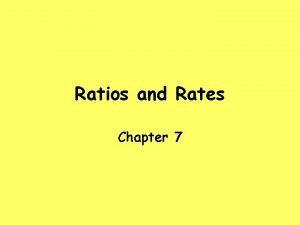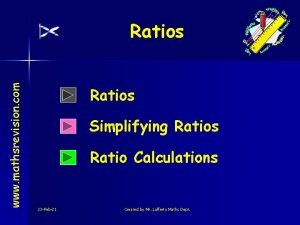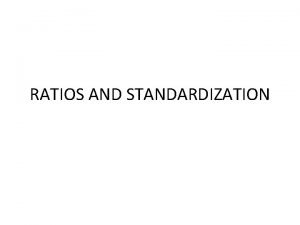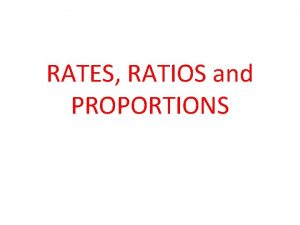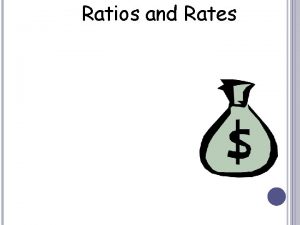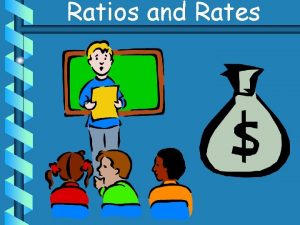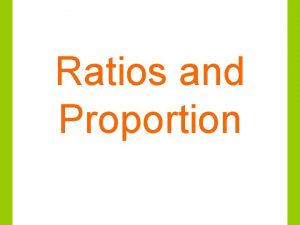Identify notation denoting ratio Calculate ratios of amounts






























- Slides: 30

• Identify notation denoting ratio. • Calculate ratios of amounts. • Order and compare common fractions, decimals and percentages to ratio. E 2 Recognise ratio notation, write quantities as a ratio. E 3 Calculate number of parts in a ratio and calculate unitary part. L 1 Work out simple ratio and direct proportion, use simple ratio expressed in the form of three parts to one part, scale quantities by a factor of two, find whole number parts of quantities and measurements without calculator. L 2 Use ratio to compare amounts and quantities, reduce ratios to simplest form, calculate ratio and direct proportion. Calculate the number of parts in a ratio, use ratio in the form a: b: c.

• Emoji pre-algebra puzzle Ratio • Topic introduction and objectives – links to daily life and study • Recap questions, 10 minutes • Co-Ed(s) present to support with reading, writing, encouragement and maintaining focus • Coloured paper available • Variety of tasks/games for reinforcement • Peer support • Explore ratio with manipulatives • Simplify simple ratio with manipulatives • • Converting units in ratio Write given quantities as ratio Recognise notation Simplify two and three part ratios Calculate unitary part Calculate shared parts Compare ratios • Calculating unitary values • Mixing paint ratio experiment – calculating correct ratios and extending. • Colour proportion as ratio, mixing colours • Daily life ratio examples – money and mixing drinks • Quiz to review unitary part and sharing • • Class charter Equipment Books Any timetable changes, absences etc • • Identifying mistakes in own work Less reliance on support and staff checking Providing peer support without realising Contributing to class discussions and providing answers, faster responses Clear interest Referring back to previous notes Familiarity with new routines, habits and methods Increased confidence with new topics/methods • • Everyday application of topics Peer support Find and correct errors Evaluate shortcomings or potential issues • Prove and disprove ideas and methods • Levelled tasks • Power. Point • Interactive applets • Maths. Bot, Connect 4, Countdown, Play Your Cards Right etc. • Stationery and Maths books • Number revision • Non-calculator methods practice

This week: • Ratio • Rounding recap Carly Hill Maths

Why do I need to know this? • Helps you practice division, multiplication • Will help you understand proportion When will I need to use this? • When sharing money • When creating a budget • When mixing – paint, recipes, drinks

10 Minute Recap • What is 14. 26 rounded to the nearest 10? • What is 179. 2 rounded to the nearest 100? • What is 1926. 1 rounded to the nearest 1000? • What is 1, 499, 602. 446 rounded to the nearest whole number? • What is 1286. 002 rounded to the nearest 10?

Ratio A ratio compares sizes of quantities. What is the ratio of red counters to blue counters? red : blue =9: 3 =3: 1 For every three red counters there is one blue counter.

Ratio The ratio of blue counters to red counters is not the same as the ratio of red counters to blue counters. What is the ratio of blue counters to red counters? blue : red =3: 9 =1: 3 For every blue counter there are three red counters.

Ratio What is the ratio of red counters to yellow counters to blue counters? red : yellow : blue = 12 : 4 : 8 = 3 : 1 : 2 For every three red counters there is one yellow counter and two blue counters.


Share £ 120 in the ratio 2: 1 Answer 3 questions: a) How many shares are there? 2: 1 = 2 + 1 = 3 b) How much is 1 share worth? £ 120 ÷ 3 = £ 40 c) How much do they get? 2 x 40 = £ 80 1 x 40= £ 40 £ 80 : £ 40

Share £ 300 in the ratio 1: 2: 3 Answer 3 questions: a) How many shares are there? 1: 2: 3 = 1 + 2 + 3 = 6 b) How much is 1 share worth? £ 300 ÷ 6 = £ 50 c) How much do they get? 1 x 50 = £ 50 2 x 50 = £ 100 3 x 50 = £ 150 £ 50 : £ 100 : £ 150


Sharing in a ratio Divide £ 40 in the ratio 2 : 3. a) How many shares are there? 2 + 3 = 5 shares b) How much is one share worth? £ 40 ÷ 5 = £ 8 Each part is worth £ 8 so, 2 parts = 2 × £ 8 = £ 16 3 parts = 3 × £ 8 = £ 24. c) How much do they get? £ 16 : £ 24 £ 16 + £ 24 = £ 40

Sharing in a ratio A citrus twist cocktail contains orange juice, lemon juice and lime juice in the ratio 6 : 3 : 1. How much of each type of juice is contained in 750 ml of the cocktail? a) How many shares are there? 6 + 3 + 1 = 10 shares b) How much is one share worth? 750 ml ÷ 10 = 75 ml c) Each part is worth 75 ml, how much do they get? 6 parts of orange juice = 6 × 75 ml = 450 ml 3 parts of lemon juice = 3 × 75 ml = 225 ml 1 part of lime juice = 75 ml

Simplifying ratio ÷ 7 Ratios can be simplified like fractions by dividing each part by the same number. 21 : 35 =3: 5 ÷ 7 6 : 12 : 9 ÷ 3 =2: 4: 3 ÷ 3


Ratio When a ratio uses different units, they need to be converted to compare them fairly. Simplify the ratio 90 p : £ 3. Write the ratio using the same units: 90 p : 300 p Then simplify it: ÷ 30 90 : 300 = 3 : 10 ÷ 30

Ratio Simplify the ratio 0. 6 m : 30 cm : 450 mm. 60 cm : 30 cm : 45 cm 60 : 30 : 45 ÷ 15 =4: 2: 3



£ 20 is shared in the ratio 1: 3 How much is 1 share worth? A) C) £ 4 £ 5 B) D) £ 1 £ 3

£ 30 is shared in the ratio 2: 3 How much is 1 share worth? A) C) £ 1 £ 2 B) D) £ 5 £ 6

£ 18 is shared in the ratio 1: 2 How much is 1 share worth? A) £ 3 B) £ 6 C) £ 2 D) £ 18

£ 45 is shared in the ratio 4: 5 How much is 1 share worth? A) C) £ 5 £ 6 B) D) £ 9 £ 4

£ 20 is shared in the ratio 1: 3 How much is 3 shares worth? A) C) £ 16 £ 3 B) D) £ 12 £ 15

£ 30 is shared in the ratio 2: 3 How much is 3 shares worth? A) £ 12 B) £ 18 C) £ 20 D) £ 15

£ 18 is shared in the ratio 1: 2 How much is 2 shares worth? A) £ 6 B) £ 12 C) £ 3 D) £ 18

£ 45 is shared in the ratio 4: 5 How much is 5 shares worth? A) C) £ 18 £ 25 B) D) £ 15 £ 20

Tom and Ellie share £ 15 in the ratio 1: 2 How much do they each get? A) Tom £ 5 Ellie £ 10 B) Tom £ 10 Ellie £ 5 C) Tom £ 3 Ellie £ 6 D) Tom £ 1 Ellie £ 2

Libby and Grant share £ 42 in the ratio 3: 4 How much do they each get? A) Libby £ 20 Grant £ 22 B) Libby £ 24 Grant £ 18 C) Libby £ 21 Grant £ 28 D) Libby £ 18 Grant £ 24
 What is a ratio notation
What is a ratio notation Associated ratios and the value of a ratio
Associated ratios and the value of a ratio Bertrand russell on denoting
Bertrand russell on denoting Proud to noun
Proud to noun Tom root word
Tom root word Cyan medical term
Cyan medical term Starboard and port side
Starboard and port side Visual aids for denoting obstacles
Visual aids for denoting obstacles In the word pelvimetry, the combining vowel is
In the word pelvimetry, the combining vowel is Mycosis a suffix denoting an abnormal condition of fungus
Mycosis a suffix denoting an abnormal condition of fungus Which suffix means to break or surgical fracture?
Which suffix means to break or surgical fracture? Rrhagia a suffix denoting excessive flow, bleeding
Rrhagia a suffix denoting excessive flow, bleeding This word part means plaque or fatty substance.
This word part means plaque or fatty substance. Scientific engineering notation
Scientific engineering notation Prefix postfix infix conversion
Prefix postfix infix conversion Reversed polish notation
Reversed polish notation Prefix polish notation
Prefix polish notation Missing angle quadrilateral
Missing angle quadrilateral Talking about amounts
Talking about amounts Small amounts of trace evidence can be conveniently
Small amounts of trace evidence can be conveniently Problem 8-3 extending amounts across the work sheet
Problem 8-3 extending amounts across the work sheet How to determine if a single replacement reaction occurs
How to determine if a single replacement reaction occurs Calculating customs bond amounts
Calculating customs bond amounts Gross enrollment rate formula
Gross enrollment rate formula How to calculate ratio and proportion
How to calculate ratio and proportion Calculate minimum reflux ratio
Calculate minimum reflux ratio What are departmental account
What are departmental account Information ratio
Information ratio How to calculate f ratio
How to calculate f ratio 5 to ratio strength
5 to ratio strength Is a gear a type of wheel
Is a gear a type of wheel
